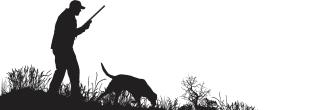
Behind the Badge - Be Prepared when Hunting with Dogs
Be Prepared when Hunting with Dogs
District Game Warden Josh Hedstrom
As we head into the fall hunting season, we prepare with our tags, licenses, and stamps and ready our firearms, bows, and the necessary hunting gear. Another responsibility is to be prepared with our hunting companions. Our trusty canines are excited to get out in the field, too.
Risks of accidents in the field are more common than we’d like to think. Whether it is a face full of quills after a run-in with a porcupine, cuts to the eyes or paws from barbed wire or wayward branches, hyperthermia or hypothermia, snake bites, or the seemingly inevitable run in with a skunk, it is essential to be prepared with a canine first aid kit and to talk with a veterinarian in your area. Just like I did while writing this to share with you.
Before even heading out, make sure your canine is up to date on vaccinations and tick control treatment. If available, take a course on canine first aid. Familiarizing yourself with canine first aid can help you keep calm so you can care for your dog in the event of an emergency.
Familiarize yourself with signs of hyperthermia (heat stroke) – excessive panting, drooling, trouble breathing, disorientation, vomiting, bright red tongue, or increased heart rate. At the first sign of heat stroke, remember to lower your dog’s body temperature gradually. Get your dog to shade and use cool water to lower its body temp. Give it cool water to drink slowly so it does not vomit.
Hypothermia is another danger to watch for, especially when your dog is venturing through water or snow. A dog’s typical body temperature is between 100.5 and 102.5 degrees. Signs for hypothermia can be a challenge to identify. Is your dog shivering in anticipation or is it cold? Is it’s breathing labored because it is having trouble breathing or is the dog winded from physical exertion? Is your dog weak, lethargic, or confused? All of these can be signs of hypothermia.
Get your dog to a warm place. Put him or her on your lap (body heat) and wrap in dog blankets or a jacket. Hypothermia is more likely to set in if your canine’s blood sugar is low. Keep your dog hydrated with warm water and if it has been a while since it has eaten, give your dog an energy boosting treat, such as honey. If the eyes have become dilated and lethargy has gotten worse, get your dog to a vet immediately.
If your dog is bitten by a snake, try to keep it calm. It is important to prevent an elevated heart rate, so you will need to carry the dog instead of letting it walk. Try to keep the wound below heart level. Keep in mind when a dog is hurt their behavior can be unpredictable. Carry Benadryl and know in advance the correct dosage for your dog’s size. Do not apply a tourniquet or cut the wound. Do not apply ice or any topical medications. Get your canine partner to a vet immediately.
If your dog sustains a cut and is bleeding, apply pressure to stop the bleeding and check for debris that may be stuck in the wound. Minor cuts may only require washing out and bandaging the wound; however, deep cuts or punctures should be checked out by a veterinarian.
Another unfortunate but common occurrence is being sprayed by a skunk. First, rinse your canine’s eyes with cool water. Give it a bath as soon as possible to remove the oil from the coat. There are numerous recipes for how to get rid of the skunk smell online, but I recommend talking to the veterinarian in your area to be sure it’s safe for your dog.
Probably one of the toughest things to watch your dog go through is a run-in with a porcupine. Try to keep your canine from rubbing the affected area against anything. Get your dog into the vet. They will be able to better assess the number and location of quills and whether some have broken off.
If quills are around the eye, that could cause serious damage. Quills near the mouth can be difficult to locate and remove. If you are comfortable attempting to remove the quills, keep your dog relaxed as possible by speaking softly. Firmly grasp a quill near the base with a flat pliers and quickly pull out in a straight line. Clean wounds with disinfectant or antiseptic.
I have had the misfortune of encountering (in some way shape or form) most of these ailments with my own dogs throughout the years. I can tell you firsthand it is important to have this information in case of an emergency.
Before you head for home, check your dog for any cuts, wounds, thorns or ticks. Check the eyes for scratches. Observe for any unusual behavior – limping, whimpering, unusual aggression – these could be signs for a sprain or broken bone.
Best practice is to be prepared…not just with your gear! Always have a first aid kit with you because you never know what could happen. Many first aid kits are available online. Do your research and talk to your vet. A good hunting experience is more than filling your tag or catching your limit… come home safely.
Basic Canine First Aid Kit
- Bandages
- Gauze
- Cotton balls
- Medical tape
- Sterile gloves
- Hand sanitizer
- Nail clippers
- Pliers
- Tweezers
- Magnifying glass
- Peroxide
- Dish soap
- Cold pack
- Hot pack
- Honey packets
- Benadryl
- Pet safe pain meds
- Cone
- Muzzle and extra leash
- Blankets
- Saline eye wash
